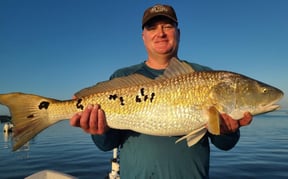We started Captain Experiences to make it easy to book fishing and hunting guides around the world. With over 1,500 Damn Good Guides, our platform makes finding and booking a trip seamless. Head here to check out our trips.
Getting into Saltwater Fly Fishing
If you're looking for a challenging and rewarding outdoor activity, fly fishing is just what you're looking for. This sport has been around for centuries, and there's a reason why it's still so popular today. Captain Ryan out of Folly Beach, South Carolina is an avid angler with light tackle and on the fly. The right setup makes a big difference and Ryan’s expertise will get you started on the right track. Here’s everything you need to know about saltwater fly fishing setups.
Fly Rod Weight (WT)
The size and strength of a fly rod referred to as the weight or “wt.” Fly rod weights range from a flimsy one weight to a hefty 16 weight. The most common and popular fly rod weights are five, eight, and ten. Inshore fly fishing requires a little more strength than freshwater. Ryan’s advice is that an “eight weight will let you catch 90% of fish but If you’re saltwater fishing, get a nine weight because a little more oomph helps new anglers cast in wind.” Depending on the species you intend to target, the weight of your rod may need to be heavier or lighter.

Fly Rod Length
Fly rods are made in a variety of different lengths from seven feet on the short end, to a maximum of around 14 feet. A nine foot fly rod is standard and effective for catching most fish. While a classic fly rod is great for most situations, rods on the short and long end of the range tend to be more specialized. Ryan explains that “some 7 foot rods are made for bass fishing while anglers spey casting for northern pike use really long rods.” The advice he gave is if you opt for something other than a nine foot rod, “longer rods help you hold a loop in the air better.”
Multi-Piece Rod Vs. One-Piece Rod
Fly rods are either one solid piece or are segmented which is known as a “multi-piece rod.” Multi-piece rods allow anglers to take them apart for easier travel. Ryan explains that “one piece rods will always be stronger which is why tarpon anglers use them, but it depends on how much convenience you need. If you’re boat fishing then one piece rods are the way to go.” In most fishing applications, the average angler will not feel a significant difference while traveling with a solid nine foot rod can be cumbersome. This is a personal preference between easy travel or slightly better strength and feel but either way it’s hard to go wrong.
Reels
Reel selection for a fly fishing setup can get complicated but Captain Ryan advises anglers to “buy a reel that’s the same weight as the rod and is made for saltwater.” The biggest differentiating factor for fly fishing reels is the drag systems they use. The drag system can have a huge impact on reel longevity. Also the reel quality required to catch certain fish varies from species to species. Ryan explains that “If you’re going for bonefish you need a good reel because they always take you into the backing while redfish don’t always get you in the backing.” His biggest piece of advice for buying a fly fishing reel is to “buy the best reel you can afford.”
Fly Line
The fish species an angler targets will influence which fly line is best for their application. Fly line needs to match the weight of your fly rod but there are two other factors to consider: water temperature and line texture. Water temperature tolerance for fly line is rated as either cold water or tropic. Cold water fly line is best for temperatures below 60 degrees, while tropic fly line is made for temperatures above 60. Using wrong temperature rated line can cause issue where the line gets curly or stiff and makes presentation difficult. Fly line is also available in textured or smooth which is more of a personal preference. Ryan explains that “general smooth all purpose saltwater line will work for 80 percent of inshore species. Textured line makes a sound which helps me work the line during the strip.”
Captain Ryan’s Advice & Recommendations
When it comes to recommendations for anglers new to inshore fly fishing, Ryan keeps it simple. Ryan recommends “a nine foot eight to nine weight multi-piece with eight or seven to nine weight reel. After that make sure to match your fly line to the region you’re going to fish. You can get away with an eight weight rod with 9 weight line line. Going up a class in line will help you cast. Fly fishing has to be harmonic so each piece of gear needs to work well together and be in harmony. Buy the best gear you can afford because you can control your gear but not the fish or weather, so having a quality setup gives you the best chances.”
If you’d like to take a trip and learn from Captain Ryan himself, you can find his trip listing here.
Joey Butrus
Updated on June 18, 2023

January 19, 2021

February 18, 2021

April 26, 2022

December 10, 2021

June 3, 2021
Related Articles
December 8, 2021
January 27, 2021
November 28, 2022


